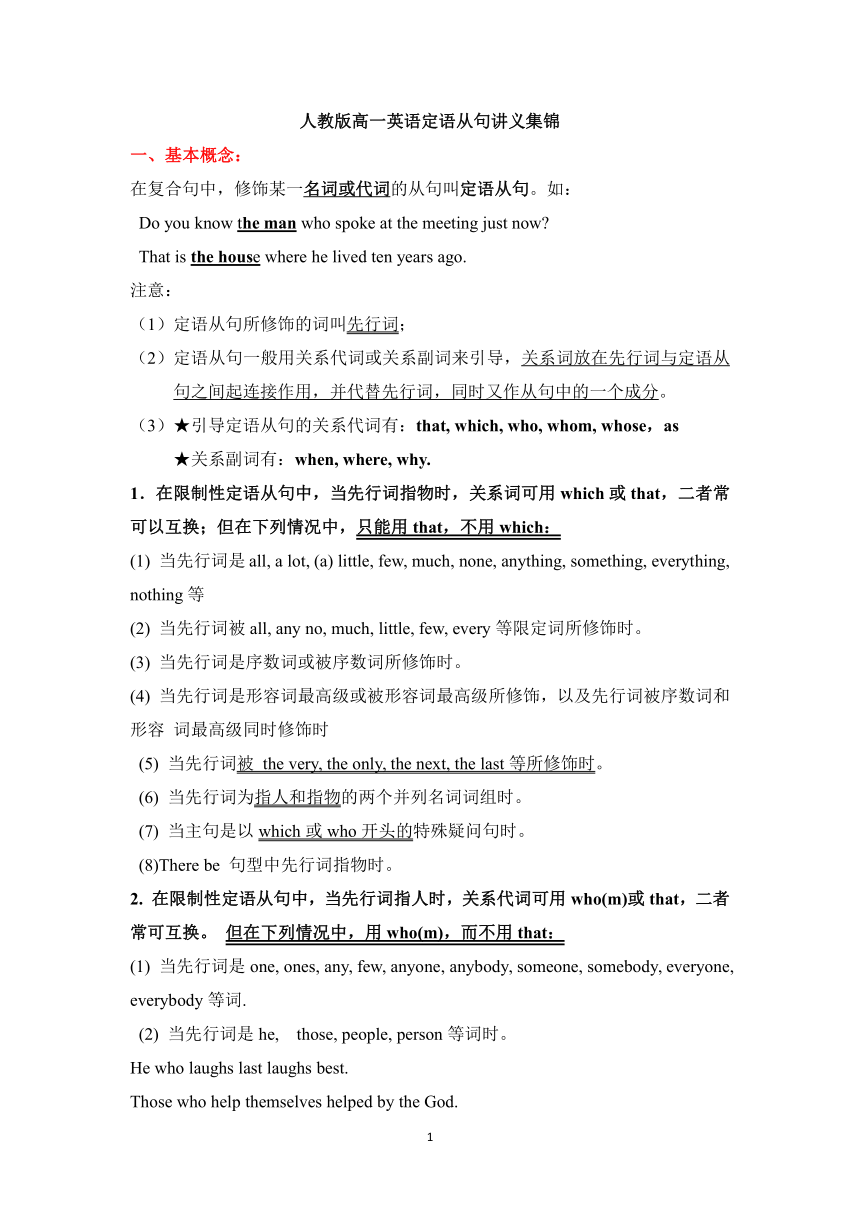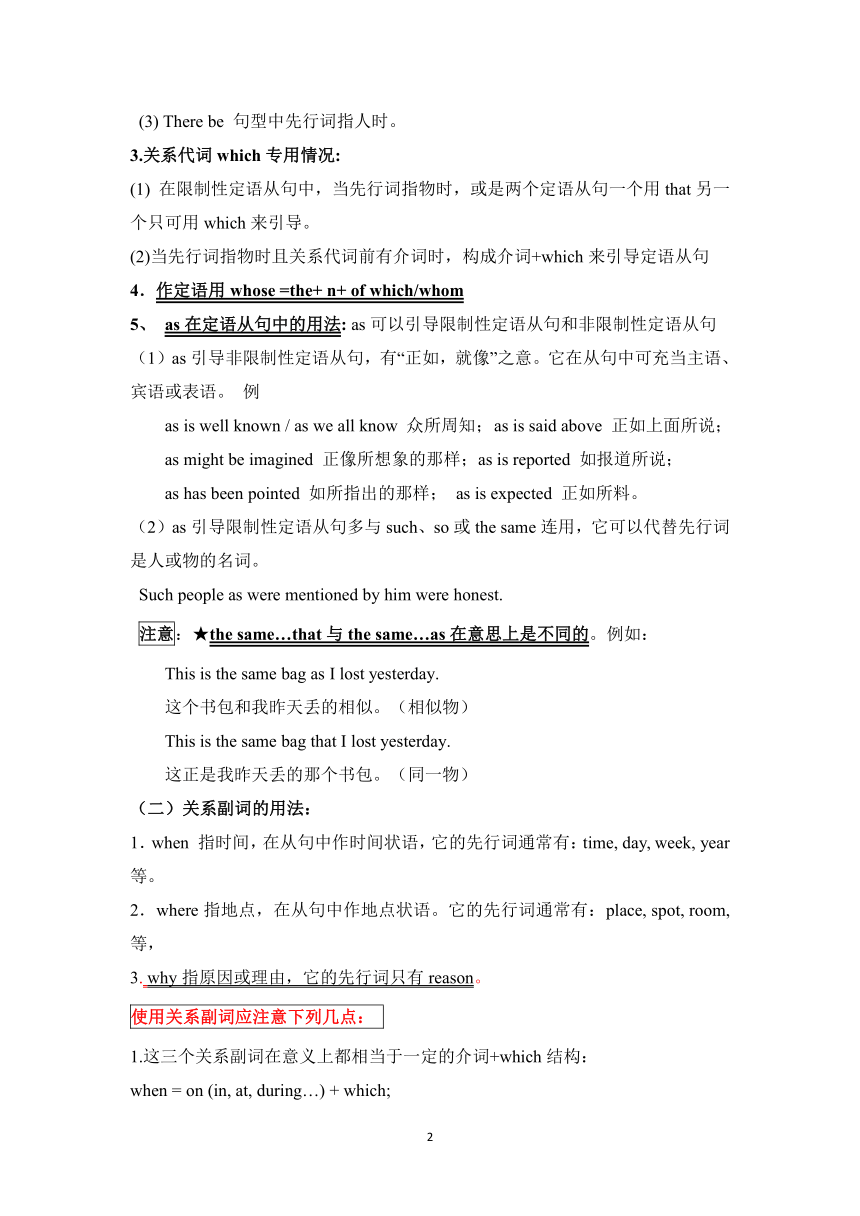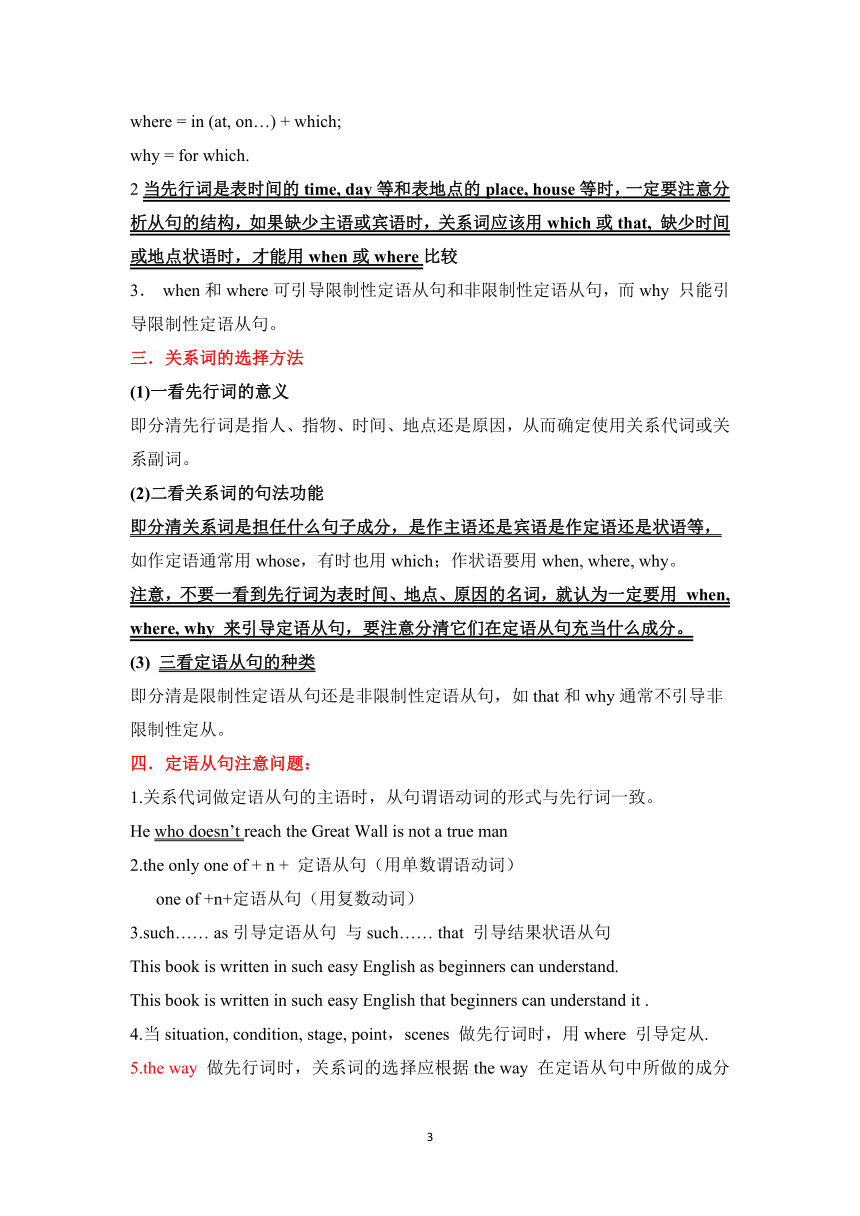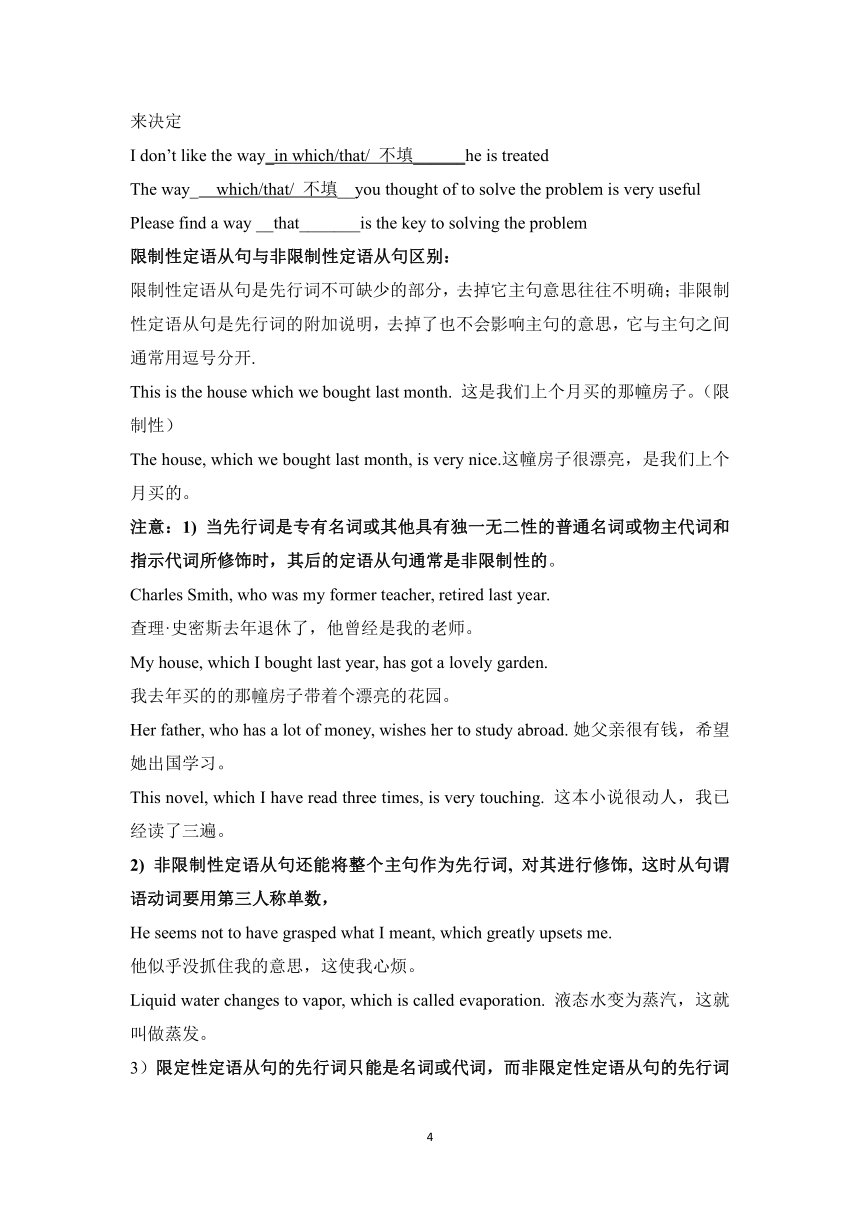人教版(2019)必修 第一册高中英语定语从句讲义集锦学案(无答案)
文档属性
| 名称 | 人教版(2019)必修 第一册高中英语定语从句讲义集锦学案(无答案) |  | |
| 格式 | docx | ||
| 文件大小 | 30.6KB | ||
| 资源类型 | 教案 | ||
| 版本资源 | 人教版(2019) | ||
| 科目 | 英语 | ||
| 更新时间 | 2023-03-18 16:35:13 | ||
图片预览




文档简介
人教版高一英语定语从句讲义集锦
一、基本概念:
在复合句中,修饰某一名词或代词的从句叫定语从句。如:
Do you know the man who spoke at the meeting just now
That is the house where he lived ten years ago.
注意:
(1)定语从句所修饰的词叫先行词;
(2)定语从句一般用关系代词或关系副词来引导,关系词放在先行词与定语从句之间起连接作用,并代替先行词,同时又作从句中的一个成分。
(3)★引导定语从句的关系代词有:that, which, who, whom, whose,as
★关系副词有:when, where, why.
1.在限制性定语从句中,当先行词指物时,关系词可用which或that,二者常可以互换;但在下列情况中,只能用that,不用which:
(1) 当先行词是all, a lot, (a) little, few, much, none, anything, something, everything, nothing等
(2) 当先行词被all, any no, much, little, few, every等限定词所修饰时。
(3) 当先行词是序数词或被序数词所修饰时。
(4) 当先行词是形容词最高级或被形容词最高级所修饰,以及先行词被序数词和形容 词最高级同时修饰时
(5) 当先行词被 the very, the only, the next, the last等所修饰时。
(6) 当先行词为指人和指物的两个并列名词词组时。
(7) 当主句是以which或who开头的特殊疑问句时。
(8)There be 句型中先行词指物时。
2. 在限制性定语从句中,当先行词指人时,关系代词可用who(m)或that,二者常可互换。 但在下列情况中,用who(m),而不用that:
(1) 当先行词是one, ones, any, few, anyone, anybody, someone, somebody, everyone, everybody等词.
(2) 当先行词是he, those, people, person等词时。
He who laughs last laughs best.
Those who help themselves helped by the God.
(3) There be 句型中先行词指人时。
3.关系代词which专用情况:
(1) 在限制性定语从句中,当先行词指物时,或是两个定语从句一个用that另一个只可用which来引导。
(2)当先行词指物时且关系代词前有介词时,构成介词+which来引导定语从句
4.作定语用whose =the+ n+ of which/whom
5、 as在定语从句中的用法: as可以引导限制性定语从句和非限制性定语从句
(1)as引导非限制性定语从句,有“正如,就像”之意。它在从句中可充当主语、宾语或表语。 例
as is well known / as we all know 众所周知; as is said above 正如上面所说;
as might be imagined 正像所想象的那样;as is reported 如报道所说;
as has been pointed 如所指出的那样; as is expected 正如所料。
(2)as引导限制性定语从句多与such、so或the same连用,它可以代替先行词是人或物的名词。
Such people as were mentioned by him were honest.
注意:★the same…that与the same…as在意思上是不同的。例如:
This is the same bag as I lost yesterday.
这个书包和我昨天丢的相似。(相似物)
This is the same bag that I lost yesterday.
这正是我昨天丢的那个书包。(同一物)
(二)关系副词的用法:
1.when 指时间,在从句中作时间状语,它的先行词通常有:time, day, week, year 等。
2.where指地点,在从句中作地点状语。它的先行词通常有:place, spot, room,等,
3. why指原因或理由,它的先行词只有reason。
使用关系副词应注意下列几点:
1.这三个关系副词在意义上都相当于一定的介词+which结构:
when = on (in, at, during…) + which;
where = in (at, on…) + which;
why = for which.
2当先行词是表时间的time, day等和表地点的place, house等时,一定要注意分析从句的结构,如果缺少主语或宾语时,关系词应该用which或that, 缺少时间或地点状语时,才能用when或where比较
3. when和where可引导限制性定语从句和非限制性定语从句,而why 只能引导限制性定语从句。
三.关系词的选择方法
(1)一看先行词的意义
即分清先行词是指人、指物、时间、地点还是原因,从而确定使用关系代词或关系副词。
(2)二看关系词的句法功能
即分清关系词是担任什么句子成分,是作主语还是宾语是作定语还是状语等,
如作定语通常用whose,有时也用which;作状语要用when, where, why。
注意,不要一看到先行词为表时间、地点、原因的名词,就认为一定要用 when, where, why 来引导定语从句,要注意分清它们在定语从句充当什么成分。
(3) 三看定语从句的种类
即分清是限制性定语从句还是非限制性定语从句,如that和why通常不引导非限制性定从。
四.定语从句注意问题:
1.关系代词做定语从句的主语时,从句谓语动词的形式与先行词一致。
He who doesn’t reach the Great Wall is not a true man
2.the only one of + n + 定语从句(用单数谓语动词)
one of +n+定语从句(用复数动词)
3.such…… as引导定语从句 与such…… that 引导结果状语从句
This book is written in such easy English as beginners can understand.
This book is written in such easy English that beginners can understand it .
4.当situation, condition, stage, point,scenes 做先行词时,用where 引导定从.
5.the way 做先行词时,关系词的选择应根据the way 在定语从句中所做的成分来决定
I don’t like the way_in which/that/ 不填______he is treated
The way_ which/that/ 不填__you thought of to solve the problem is very useful
Please find a way __that_______is the key to solving the problem
限制性定语从句与非限制性定语从句区别:
限制性定语从句是先行词不可缺少的部分,去掉它主句意思往往不明确;非限制性定语从句是先行词的附加说明,去掉了也不会影响主句的意思,它与主句之间通常用逗号分开.
This is the house which we bought last month. 这是我们上个月买的那幢房子。(限制性)
The house, which we bought last month, is very nice.这幢房子很漂亮,是我们上个月买的。
注意:1) 当先行词是专有名词或其他具有独一无二性的普通名词或物主代词和指示代词所修饰时,其后的定语从句通常是非限制性的。
Charles Smith, who was my former teacher, retired last year.
查理·史密斯去年退休了,他曾经是我的老师。
My house, which I bought last year, has got a lovely garden.
我去年买的的那幢房子带着个漂亮的花园。
Her father, who has a lot of money, wishes her to study abroad. 她父亲很有钱,希望她出国学习。
This novel, which I have read three times, is very touching. 这本小说很动人,我已经读了三遍。
2) 非限制性定语从句还能将整个主句作为先行词, 对其进行修饰, 这时从句谓语动词要用第三人称单数,
He seems not to have grasped what I meant, which greatly upsets me.
他似乎没抓住我的意思,这使我心烦。
Liquid water changes to vapor, which is called evaporation. 液态水变为蒸汽,这就叫做蒸发。
3)限定性定语从句的先行词只能是名词或代词,而非限定性定语从句的先行词则可以是名词或代词,也可以是短语或句子。
Peter drove too fast, which was dangerous. 彼得开车很快,这是很危险的。(which指drive too fast)
He changed his mind, which made me very angry. 他改变了主意,这使我很生气。(which指整个主句)
4)关系词that和why可用于限制性定语从句中,通常不用于非限制性定语从句;另外,在限制性定语从句中,关系代词作宾语可以省略,而在非限制性定语从句中关系词一律不省略。
一.★as 和which 引导定语从句的区别
有时,非限制性定语从句所修饰的不是某一个词,而是整个主句或是主句中的一个部分,这时一般采用which或as来引导。如:
He passed the exam, which/as he hoped he would.
(1)as引导的从句可以放在主句之前,而which引导的从句只能放在主句之后。
They are hollow, which makes them very light.
As is known to all, Taiwan is a part of China.
(2)从意义上讲,which指前面主句的内容;而as指代的是作为一般人都知道的常识性的东西,因此常译成“就象… …那样”。
(3)as引导的非限制性定语从句表示积极的意义,与主句是顺理成章的关系,绝不能与之矛盾。若非限制性定语从句表示消极的意义,则只用which。如:
He has succeeded in his career, as / which we all hope.
他在事业中成功了,这正是我们大家所希
Her grandma died last week, which made her very sad.
她的奶奶逝世了,这使得她很悲伤。
(4) 当非限制性定语从句的引导词前面有介词时,只能用which, 而不可用 as。如:
He has a new computer, for which he paid nearly ten thousand Yuan.
(5)关系代词仅代表主句中单个的名词时,一般只用which, 而不用as。如:
He sent me a beautiful present, which I valued very much.
(6) as在非限制性定语从句中常用于一些固定结构中。如:
as is well known / as we all know 众所周知;
as is said above 正如上面所说;as often happens正如经常发生的
as might/may be imagined 正像所想象的那样;
as is/was reported 如报道所说;as is/was expected 正如所料
as has been pointed 如所指出的那样; as has been said before如前所述
注意:as 在限制性定语从句中,常跟such/ so/as/ the same连用。如:
He spoke in such easy English as everybody could understand.
At this time of the day, all buses have to carry as many passengers as they can.
It is so easy a book as every schoolboy can read.
注意:★the same…that与the same…as在意思上是不同的。例如:
This is the same bag as I lost yesterday.
这个书包和我昨天丢的相似。(相似物)
This is the same bag that I lost yesterday.
这正是我昨天丢的那个书包。(同一物)
二.介词+关系代词 引导的定语从句
当关系代词作介词宾语,且该介词不是和从句的谓语动词构成固定短语时,介词可以提前,这样就出现“介词+关系代词”。先行词指物,用“介词+which/whose”,指人则用“介词+whom/whose”, 且两个关系代词均不能省略。
介词的确定要遵从“一先,二动,三意义“的原则。”一先“根据先行词的某种习惯搭配确定介词;”二动“根据定语从句中动词所修要的某种习惯搭配确定介词;”三意义“根据从句的意义来确定介词.
______which I spent 5 yuan.
_______which I paid 5 yuan.
1.This is the book ________which I learnt a lot.
________which Tom often talks.
the day _______which I joined the Party.
2.I remember the days______which I lived here.
the month_______which I stayed there.
3.The glasses________ he is like a blind man can’t do anything.
A. with which B. in which C. on which D. without which
(注意:有些动词短语一般不拆开使用,如:look for, look after, take care of 等)
This is the watch which/that I am looking for .
注意:在下列情况下,一般只用of whom和of which。
定语从句的主语是few, little, some, most, many, much等时,一般只用of whom和of which。
In the room are lots of people, many of whom I don’t know.
He has a lot of story-books, a few of which I have never read.
(2) 定语从句的主语是数词、形容词的最高级时,一般只用of whom和of which。如:
The old man has three children, two of whom are college students and one of whom is a manager.
定语从句的主语是all, none, both, neither, each等不定代词时,一般只用of whom和of which。
There are fifty students in our class, all of whom are working hard.
He planted two trees last year, both of which are growing well.
(4) 在定语从句中作表语的定语时,一般只用of whom和of which。如:
He has three brothers, of whom Li Lei is the youngest one.
There are many countries in Asia, of which China is the largest one.
(5)在非限制性定语从句中,★表示“部分与整体”的关系时,用…of which/whom或者of which/whom…都可以。表示部分的可以是具体数目或百分数,也可以是few, several, some, half, many, much, most, all, none, either, neither, a quarter, a number, the larger, the smallest, the majority等。
Our school has 80 teachers, 50 of whom (=of whom 50) are women.
He has lots of books, most of which are English ones.
注意这里的of which不能用whose代替,这与表示所属关系的of which不同:
三. 定语从句与其它从句(句型)的区别
1. 定语从句与并列句
定语从句与并列句的主要区别在于:并列句有像and,but,so等并列连词或两个句子用分号连接,这时就不能再用引导定语从句的关系词了
①Mr Li has three daughters,none of _____ is an engineer.
②Mr Li has three daughters,but none of _____ is a dancer.
2. 定语从句与状语从句
(1) 定语从句的前面有名词作先行词,而状语从句没有先行词。
This is the place where we used to live a few years ago.
这是几年前我们居住的地方。(定语从句,先行词为the place)
Let’s go where we can find a better job.
我们到能找到更好的工作的地方去吧。(地点状语从句)
(2)定语从句修饰、限制、说明名词,只能放在先行词的后面,而状语从句说明动作发生的情况,并且可以放在主句的前面。
Do you know the time when the class is over 你知道下课的时间吗?(定语从句)
It was already five o’clock when the class was over.
=When the class was over, it was already five o’clock.
当下课时己经是5点了。(时间状语从句)
注意:When, where和why在引导定语从句时可以用“介词+which”的结构来替换,在引导状语从句时却不行。
This is the factory in which (where) his father once worked.
这就是他的父亲曾经工作过的那个工厂。(定语从句)
Put back the book where it was. 把书放回原处。(状语从句)
(3)限制性定语从句中的关系词在从句中充当某种句子成分,因此去掉它则从句成分不完整;而结果状语从句中的连接词在从句中不作任何成分,去掉后从句的成分仍然完整。
It is such an interesting book as we all like. 它是我们大家都喜欢的如此有趣的书。
(as用作动词like的宾语,它引导的是定语从句)
It is such an interesting book that we all like it.
它是一本如此有趣的书,我们大家都喜欢它。
that不充当句子成分,故它引导的是结果状语从句)
3.定语从句与同位语从句
定语从句在复合句中相当于形容词,对先行词起修饰、描述或限制的作用,与先行词之间有从属关系。同位语的作用相当于名词,对前面的名词给予补充说明或进一步解释,是前面名词的具体内容,与先行词之间是同位关系。
The news that she had passed the exam made her parents very happy.
她考试及格的消息使她父母亲很高兴。(同位语从句)
The news that he told us interested all of us.
他告诉我们的消息使大家都感兴趣。(定语从句)
4.定语从句与强调句
强调句的结构为“It is/was+被强调部分+that/who+从句”。被强调部分可以是除谓语以外的任何成分,当被强调部分是人时,还可用who代替that。这一句型中,一定不能因为被强调部分是表时间或地点的词就用when或where代替 that。
①It is on the morning of May 1st _____ I met Liang Wei at the airport.
②It is the factory _____ Mr Wang works.
此外还要注意下列几点:
▲定语从句与习惯句型
用一个恰当的词完成下列句子,使之完整与正确。
①It is the first time _____ she has been in Shanghai.
②It was the time _____ Chinese people had a hard life.
▲定语从句与简单句
用一个恰当的词完成下列句子,使之完整与正确。
①The mother told the lazy boy to work,_____ didn't help.
②The mother told the lazy boy to work._____ didn't help.
▲在定语从句加中插入语,常见的有:I think ,I suppose ,I guess ,I imagine等。辨别的方法是:去掉插入语后,原句句法结构仍然完整
He made another wonderful discovery ,______of importance to science .
A. which I think is B. which I think it is
C. which I think it D. I think is
一、基本概念:
在复合句中,修饰某一名词或代词的从句叫定语从句。如:
Do you know the man who spoke at the meeting just now
That is the house where he lived ten years ago.
注意:
(1)定语从句所修饰的词叫先行词;
(2)定语从句一般用关系代词或关系副词来引导,关系词放在先行词与定语从句之间起连接作用,并代替先行词,同时又作从句中的一个成分。
(3)★引导定语从句的关系代词有:that, which, who, whom, whose,as
★关系副词有:when, where, why.
1.在限制性定语从句中,当先行词指物时,关系词可用which或that,二者常可以互换;但在下列情况中,只能用that,不用which:
(1) 当先行词是all, a lot, (a) little, few, much, none, anything, something, everything, nothing等
(2) 当先行词被all, any no, much, little, few, every等限定词所修饰时。
(3) 当先行词是序数词或被序数词所修饰时。
(4) 当先行词是形容词最高级或被形容词最高级所修饰,以及先行词被序数词和形容 词最高级同时修饰时
(5) 当先行词被 the very, the only, the next, the last等所修饰时。
(6) 当先行词为指人和指物的两个并列名词词组时。
(7) 当主句是以which或who开头的特殊疑问句时。
(8)There be 句型中先行词指物时。
2. 在限制性定语从句中,当先行词指人时,关系代词可用who(m)或that,二者常可互换。 但在下列情况中,用who(m),而不用that:
(1) 当先行词是one, ones, any, few, anyone, anybody, someone, somebody, everyone, everybody等词.
(2) 当先行词是he, those, people, person等词时。
He who laughs last laughs best.
Those who help themselves helped by the God.
(3) There be 句型中先行词指人时。
3.关系代词which专用情况:
(1) 在限制性定语从句中,当先行词指物时,或是两个定语从句一个用that另一个只可用which来引导。
(2)当先行词指物时且关系代词前有介词时,构成介词+which来引导定语从句
4.作定语用whose =the+ n+ of which/whom
5、 as在定语从句中的用法: as可以引导限制性定语从句和非限制性定语从句
(1)as引导非限制性定语从句,有“正如,就像”之意。它在从句中可充当主语、宾语或表语。 例
as is well known / as we all know 众所周知; as is said above 正如上面所说;
as might be imagined 正像所想象的那样;as is reported 如报道所说;
as has been pointed 如所指出的那样; as is expected 正如所料。
(2)as引导限制性定语从句多与such、so或the same连用,它可以代替先行词是人或物的名词。
Such people as were mentioned by him were honest.
注意:★the same…that与the same…as在意思上是不同的。例如:
This is the same bag as I lost yesterday.
这个书包和我昨天丢的相似。(相似物)
This is the same bag that I lost yesterday.
这正是我昨天丢的那个书包。(同一物)
(二)关系副词的用法:
1.when 指时间,在从句中作时间状语,它的先行词通常有:time, day, week, year 等。
2.where指地点,在从句中作地点状语。它的先行词通常有:place, spot, room,等,
3. why指原因或理由,它的先行词只有reason。
使用关系副词应注意下列几点:
1.这三个关系副词在意义上都相当于一定的介词+which结构:
when = on (in, at, during…) + which;
where = in (at, on…) + which;
why = for which.
2当先行词是表时间的time, day等和表地点的place, house等时,一定要注意分析从句的结构,如果缺少主语或宾语时,关系词应该用which或that, 缺少时间或地点状语时,才能用when或where比较
3. when和where可引导限制性定语从句和非限制性定语从句,而why 只能引导限制性定语从句。
三.关系词的选择方法
(1)一看先行词的意义
即分清先行词是指人、指物、时间、地点还是原因,从而确定使用关系代词或关系副词。
(2)二看关系词的句法功能
即分清关系词是担任什么句子成分,是作主语还是宾语是作定语还是状语等,
如作定语通常用whose,有时也用which;作状语要用when, where, why。
注意,不要一看到先行词为表时间、地点、原因的名词,就认为一定要用 when, where, why 来引导定语从句,要注意分清它们在定语从句充当什么成分。
(3) 三看定语从句的种类
即分清是限制性定语从句还是非限制性定语从句,如that和why通常不引导非限制性定从。
四.定语从句注意问题:
1.关系代词做定语从句的主语时,从句谓语动词的形式与先行词一致。
He who doesn’t reach the Great Wall is not a true man
2.the only one of + n + 定语从句(用单数谓语动词)
one of +n+定语从句(用复数动词)
3.such…… as引导定语从句 与such…… that 引导结果状语从句
This book is written in such easy English as beginners can understand.
This book is written in such easy English that beginners can understand it .
4.当situation, condition, stage, point,scenes 做先行词时,用where 引导定从.
5.the way 做先行词时,关系词的选择应根据the way 在定语从句中所做的成分来决定
I don’t like the way_in which/that/ 不填______he is treated
The way_ which/that/ 不填__you thought of to solve the problem is very useful
Please find a way __that_______is the key to solving the problem
限制性定语从句与非限制性定语从句区别:
限制性定语从句是先行词不可缺少的部分,去掉它主句意思往往不明确;非限制性定语从句是先行词的附加说明,去掉了也不会影响主句的意思,它与主句之间通常用逗号分开.
This is the house which we bought last month. 这是我们上个月买的那幢房子。(限制性)
The house, which we bought last month, is very nice.这幢房子很漂亮,是我们上个月买的。
注意:1) 当先行词是专有名词或其他具有独一无二性的普通名词或物主代词和指示代词所修饰时,其后的定语从句通常是非限制性的。
Charles Smith, who was my former teacher, retired last year.
查理·史密斯去年退休了,他曾经是我的老师。
My house, which I bought last year, has got a lovely garden.
我去年买的的那幢房子带着个漂亮的花园。
Her father, who has a lot of money, wishes her to study abroad. 她父亲很有钱,希望她出国学习。
This novel, which I have read three times, is very touching. 这本小说很动人,我已经读了三遍。
2) 非限制性定语从句还能将整个主句作为先行词, 对其进行修饰, 这时从句谓语动词要用第三人称单数,
He seems not to have grasped what I meant, which greatly upsets me.
他似乎没抓住我的意思,这使我心烦。
Liquid water changes to vapor, which is called evaporation. 液态水变为蒸汽,这就叫做蒸发。
3)限定性定语从句的先行词只能是名词或代词,而非限定性定语从句的先行词则可以是名词或代词,也可以是短语或句子。
Peter drove too fast, which was dangerous. 彼得开车很快,这是很危险的。(which指drive too fast)
He changed his mind, which made me very angry. 他改变了主意,这使我很生气。(which指整个主句)
4)关系词that和why可用于限制性定语从句中,通常不用于非限制性定语从句;另外,在限制性定语从句中,关系代词作宾语可以省略,而在非限制性定语从句中关系词一律不省略。
一.★as 和which 引导定语从句的区别
有时,非限制性定语从句所修饰的不是某一个词,而是整个主句或是主句中的一个部分,这时一般采用which或as来引导。如:
He passed the exam, which/as he hoped he would.
(1)as引导的从句可以放在主句之前,而which引导的从句只能放在主句之后。
They are hollow, which makes them very light.
As is known to all, Taiwan is a part of China.
(2)从意义上讲,which指前面主句的内容;而as指代的是作为一般人都知道的常识性的东西,因此常译成“就象… …那样”。
(3)as引导的非限制性定语从句表示积极的意义,与主句是顺理成章的关系,绝不能与之矛盾。若非限制性定语从句表示消极的意义,则只用which。如:
He has succeeded in his career, as / which we all hope.
他在事业中成功了,这正是我们大家所希
Her grandma died last week, which made her very sad.
她的奶奶逝世了,这使得她很悲伤。
(4) 当非限制性定语从句的引导词前面有介词时,只能用which, 而不可用 as。如:
He has a new computer, for which he paid nearly ten thousand Yuan.
(5)关系代词仅代表主句中单个的名词时,一般只用which, 而不用as。如:
He sent me a beautiful present, which I valued very much.
(6) as在非限制性定语从句中常用于一些固定结构中。如:
as is well known / as we all know 众所周知;
as is said above 正如上面所说;as often happens正如经常发生的
as might/may be imagined 正像所想象的那样;
as is/was reported 如报道所说;as is/was expected 正如所料
as has been pointed 如所指出的那样; as has been said before如前所述
注意:as 在限制性定语从句中,常跟such/ so/as/ the same连用。如:
He spoke in such easy English as everybody could understand.
At this time of the day, all buses have to carry as many passengers as they can.
It is so easy a book as every schoolboy can read.
注意:★the same…that与the same…as在意思上是不同的。例如:
This is the same bag as I lost yesterday.
这个书包和我昨天丢的相似。(相似物)
This is the same bag that I lost yesterday.
这正是我昨天丢的那个书包。(同一物)
二.介词+关系代词 引导的定语从句
当关系代词作介词宾语,且该介词不是和从句的谓语动词构成固定短语时,介词可以提前,这样就出现“介词+关系代词”。先行词指物,用“介词+which/whose”,指人则用“介词+whom/whose”, 且两个关系代词均不能省略。
介词的确定要遵从“一先,二动,三意义“的原则。”一先“根据先行词的某种习惯搭配确定介词;”二动“根据定语从句中动词所修要的某种习惯搭配确定介词;”三意义“根据从句的意义来确定介词.
______which I spent 5 yuan.
_______which I paid 5 yuan.
1.This is the book ________which I learnt a lot.
________which Tom often talks.
the day _______which I joined the Party.
2.I remember the days______which I lived here.
the month_______which I stayed there.
3.The glasses________ he is like a blind man can’t do anything.
A. with which B. in which C. on which D. without which
(注意:有些动词短语一般不拆开使用,如:look for, look after, take care of 等)
This is the watch which/that I am looking for .
注意:在下列情况下,一般只用of whom和of which。
定语从句的主语是few, little, some, most, many, much等时,一般只用of whom和of which。
In the room are lots of people, many of whom I don’t know.
He has a lot of story-books, a few of which I have never read.
(2) 定语从句的主语是数词、形容词的最高级时,一般只用of whom和of which。如:
The old man has three children, two of whom are college students and one of whom is a manager.
定语从句的主语是all, none, both, neither, each等不定代词时,一般只用of whom和of which。
There are fifty students in our class, all of whom are working hard.
He planted two trees last year, both of which are growing well.
(4) 在定语从句中作表语的定语时,一般只用of whom和of which。如:
He has three brothers, of whom Li Lei is the youngest one.
There are many countries in Asia, of which China is the largest one.
(5)在非限制性定语从句中,★表示“部分与整体”的关系时,用…of which/whom或者of which/whom…都可以。表示部分的可以是具体数目或百分数,也可以是few, several, some, half, many, much, most, all, none, either, neither, a quarter, a number, the larger, the smallest, the majority等。
Our school has 80 teachers, 50 of whom (=of whom 50) are women.
He has lots of books, most of which are English ones.
注意这里的of which不能用whose代替,这与表示所属关系的of which不同:
三. 定语从句与其它从句(句型)的区别
1. 定语从句与并列句
定语从句与并列句的主要区别在于:并列句有像and,but,so等并列连词或两个句子用分号连接,这时就不能再用引导定语从句的关系词了
①Mr Li has three daughters,none of _____ is an engineer.
②Mr Li has three daughters,but none of _____ is a dancer.
2. 定语从句与状语从句
(1) 定语从句的前面有名词作先行词,而状语从句没有先行词。
This is the place where we used to live a few years ago.
这是几年前我们居住的地方。(定语从句,先行词为the place)
Let’s go where we can find a better job.
我们到能找到更好的工作的地方去吧。(地点状语从句)
(2)定语从句修饰、限制、说明名词,只能放在先行词的后面,而状语从句说明动作发生的情况,并且可以放在主句的前面。
Do you know the time when the class is over 你知道下课的时间吗?(定语从句)
It was already five o’clock when the class was over.
=When the class was over, it was already five o’clock.
当下课时己经是5点了。(时间状语从句)
注意:When, where和why在引导定语从句时可以用“介词+which”的结构来替换,在引导状语从句时却不行。
This is the factory in which (where) his father once worked.
这就是他的父亲曾经工作过的那个工厂。(定语从句)
Put back the book where it was. 把书放回原处。(状语从句)
(3)限制性定语从句中的关系词在从句中充当某种句子成分,因此去掉它则从句成分不完整;而结果状语从句中的连接词在从句中不作任何成分,去掉后从句的成分仍然完整。
It is such an interesting book as we all like. 它是我们大家都喜欢的如此有趣的书。
(as用作动词like的宾语,它引导的是定语从句)
It is such an interesting book that we all like it.
它是一本如此有趣的书,我们大家都喜欢它。
that不充当句子成分,故它引导的是结果状语从句)
3.定语从句与同位语从句
定语从句在复合句中相当于形容词,对先行词起修饰、描述或限制的作用,与先行词之间有从属关系。同位语的作用相当于名词,对前面的名词给予补充说明或进一步解释,是前面名词的具体内容,与先行词之间是同位关系。
The news that she had passed the exam made her parents very happy.
她考试及格的消息使她父母亲很高兴。(同位语从句)
The news that he told us interested all of us.
他告诉我们的消息使大家都感兴趣。(定语从句)
4.定语从句与强调句
强调句的结构为“It is/was+被强调部分+that/who+从句”。被强调部分可以是除谓语以外的任何成分,当被强调部分是人时,还可用who代替that。这一句型中,一定不能因为被强调部分是表时间或地点的词就用when或where代替 that。
①It is on the morning of May 1st _____ I met Liang Wei at the airport.
②It is the factory _____ Mr Wang works.
此外还要注意下列几点:
▲定语从句与习惯句型
用一个恰当的词完成下列句子,使之完整与正确。
①It is the first time _____ she has been in Shanghai.
②It was the time _____ Chinese people had a hard life.
▲定语从句与简单句
用一个恰当的词完成下列句子,使之完整与正确。
①The mother told the lazy boy to work,_____ didn't help.
②The mother told the lazy boy to work._____ didn't help.
▲在定语从句加中插入语,常见的有:I think ,I suppose ,I guess ,I imagine等。辨别的方法是:去掉插入语后,原句句法结构仍然完整
He made another wonderful discovery ,______of importance to science .
A. which I think is B. which I think it is
C. which I think it D. I think is
